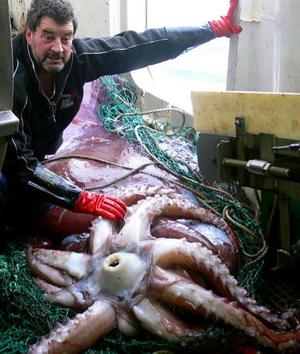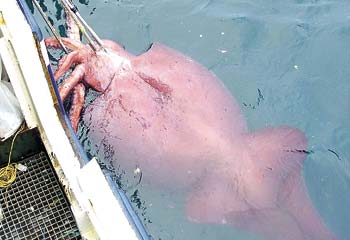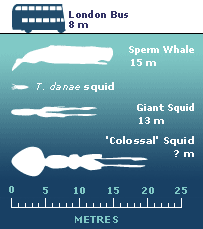Largest Colossal Squid Ever
Posted by: Loren Coleman on February 22nd, 2007
I can assure you that this is going to draw phenomenal interest. It is truly amazing.Steve O’Shea
Auckland’s University of Technology

On February 22, 2007, various sources, including the BBC News announced that New Zealand Fisheries Minister Jim Anderton said a Colossal Squid ( Mesonychoteuthis hamiltoni), estimated as 33 feet (10 meters) long and 990 pound (450 kilograms) in weight, has been captured.
Fishermen on the vessel San Aspiring, owned by the Sanford seafood company, caught the animal in the cold Antarctic waters of the Ross Sea. It was brought to the surface as it fed on a Patagonian toothfish that had been caught off a long line. The specimen eclipsed the previous largest find. The new specimen is still shorter than some larger estimates have predicted. Bigger examples may be seen in the future.

The 450 kg squid is hauled beside the fishing boat and brought aboard. Picture: NZ Ministry of Fisheries / AAP
Colossal squid, which are found deep in Antarctic waters, are thought to be about the same length as giant squid (Architeutis dux) but are much heavier. The species was first identified in 1925, but very few specimens have been found. The first specimen recovered intact, a 150 kg (330 lb) immature female, was caught on the surface in the Ross Sea near the Antarctic coast in April 2004.BCC News

About Loren Coleman
Loren Coleman is one of the world’s leading cryptozoologists, some say “the” leading living cryptozoologist. Certainly, he is acknowledged as the current living American researcher and writer who has most popularized cryptozoology in the late 20th and early 21st centuries.
Starting his fieldwork and investigations in 1960, after traveling and trekking extensively in pursuit of cryptozoological mysteries, Coleman began writing to share his experiences in 1969. An honorary member of Ivan T. Sanderson’s Society for the Investigation of the Unexplained in the 1970s, Coleman has been bestowed with similar honorary memberships of the North Idaho College Cryptozoology Club in 1983, and in subsequent years, that of the British Columbia Scientific Cryptozoology Club, CryptoSafari International, and other international organizations. He was also a Life Member and Benefactor of the International Society of Cryptozoology (now-defunct).
Loren Coleman’s daily blog, as a member of the Cryptomundo Team, served as an ongoing avenue of communication for the ever-growing body of cryptozoo news from 2005 through 2013. He returned as an infrequent contributor beginning Halloween week of 2015.
Coleman is the founder in 2003, and current director of the International Cryptozoology Museum in Portland, Maine.










Well, of course it’s a shame that it’s dead, but at the end of the day science needs specimens and that is a ruddy good example.
Cheers for posting Loren.
Can’t really ask for much better confirmation of a former cryptid than this.
Impressive find.
I hope these squids taste terrible, otherwise it’s goodbye squid.
Ok, now I can confirm it. You really DO learn something new every day.
I’m an animal guy. All kinds.
And I’d never heard of this one.
The collosal squid is one fascinating creature and really one of the most fearsome predators on the planet. Giant squid are impressive, but these are downright scary. Their tentacles are equipped with huge claws and they can move incredibly fast considering the water pressure they live under. Add to that incredible manueverability. And apparently, they have found beaks in the stomachs of dead whales that point to even bigger specimens than this. This is an amazing find. It would be interesting to get live footage on this particular species similar in quality to the footage taken by the Japanese crew of a giant squid.
It’s absolutely amazing how animals this large can exist without being seen for so long. Also, the fact that they have adapted to the massive pressure of the deep sea is remarkable. Is it possible that other giant cephalopods live in the depths and trenches around the world? Perhaps a giant octopus or cuttlefish?
In conclusion, I would like to eat one with marinara and hot peppers.
This gives hope that giant octopi may still be out there somewhere.
All hail Cthulhu!
I had not heard of a Colossal squid until this morning, and had no idea there was anything bigger than the Giant Squid. Wow. They’re really massive in comparison! I now know that there is a distinction between “just plain big” and “really, really big”.
The thought of a giant cuttlefish is cool. I love cuttlefish. 🙂
Impressive as it is it still is a far cry from Jule Verne’s 2000 Leagues Under The Sea monster. One question that’s never been answered to me is when they say the squid is 33 feet long. Do they include in that figure the length of the tentacles? Because if they do that sounds like cheating.
Thanks for posting about the Colossal Calamari. I enjoyed this immensely–pun intended.
Dorian West: Do they include your legs when they measure your hieght?
The squid was eating a patagonian toothfish, which is presumably what the fishermen were after.
Patagonian toothfish in the US is sold as “Chilean seabass” (even though it’s neither Chilean, nor bass) and is under heavy threat from overfishing.
This specimen was 10m including the two long tentacles, its mantle length was probably about 3m. It is a male, and females are even a bit bigger, but until now not known from complete specimens. One reason why this animals are so rarely seen, is that they have a comparably limited range, whereas the giant squid is nearly cosmopolitan.
I also did not know about this creature until today. I knew about the giant squid, but did not know about the collosal squid. Here’s a Wikipedia article on this creature.
There have been reports of sperm whales with suction cup scars 12 inches in diameter…if that’s true, this one is a baby!
The ocean is the final frontier for human exploration and there are wonders to be discovered.
Of course they measure your legs when they measure your height. They don’t, on the otherhand, measure you with your arms up as if grasping for cornflakes on the top shelf
Due to the heavy whaling in the last 50 years or so, perhaps large populations of these deep dwellers have been able to repopulate themselves. In the past two years, we’ve seen many fine examples of these mythic creatures in the press. I predict that within the next year, some deep sea film team will coax one of these giants, or even colossal types, to attack a sub.
I don’t think it’s the heavy whaling so much as the increasingly aggressive deep-sea commercial fishing.
In this case, the boat in question appears to have been after patagonian toothfish (aka “Chilean seabass”), which have been overfished to where fishermen have to go deeper and deeper to find them.
See http://www.state.gov/g/oes/rls/fs/2002/8989.htm
and http://en.wikipedia.org/wiki/Patagonian_toothfish
As soon as I saw it on CNN I figured you guys would post it immediately. Fantastic creature!
O.K. Now I know where I won’t be deep sea diving.
The 12 inches sucker marks are just a myth which emerged due to copy mistakes in the literature. Please consult the books of Richard Ellis if you want know the exact details. The suckers of large giant squids are about 3 inches in diameter, although you can often read about dinner-plate-sized suckers.
No es el más grande, es el más pesado. En Santa Cruz de Tenerife en 1998 la embarcación Batros I capturo un ejemplar de Architeutix Dux de también 10 metros de longitud y 350 kg de peso, por lo cual no es el más grande, sino el mas pesado.
En la actualidad ese ejemplar se encuentra congelado en el museo de Ciencias Naturales de Santa Cruz de Tenerife, donde han construido una maqueta de resina a tamaño natural.
Sordes is right about the sucker marks. It is a common misconception that whales are found with huge sucker marks that point to enormous monster squid. Rather, it is the beaks of the squid found in the whales stomachs that usually give a clue to the size of some of the squid out there.
Can someone explain something for me please, I may be mssing the obvious. At 10m this is the largest Colossal Squid ever caught? The diagram with sperm whale shows the Giant Squid at 13m. Is the a recorded length for a Giant Squid? If so does that mean the largest Colossal Squid still isn’t as large as the largest Giant Squid? Or it just a weight thing as suggested?
I’m confused…
The largest known giant squid (Architeuthis dux) was about 13m in length and had a weight of about 220kg. But most of their complete length consists of their two long tentacles, the body of a 10m long colossal squid (Mesonychoteuthis hamiltoni) is much bigger and heaver, the difference in total length is just some ounces of tentacle tissue. Anyway, this was the largest colossal squid which is known until now. Most probably females are a bit bigger and reach a length of about 14m or so.
Thanks Sordes
wowsers, i had no idea there was a bigger squid out there than our buddy archie. Thanks for posting this one.
I read on Where Light Meets Dark about another large squid that was pulled in (already dead) near the Florida keys. It was not an Architeuthis . Some were speculating that it could be an immature Mesonychoteuthis; others that it might be a previously undiscovered species.
I have not seen or heard any more about it though.
I have heard that centuries ago, when trade was always via ships, that there were many encounters with Sea “Monsters”. Then they don’t know what to make of them, they didn’t have the knowledge we have now they only knew that something horrendously gigantic was eating they’re ships, their cargo and their sailors. Hundreds of years ago, there was no way to truly prove the experiences of those who survived those deadly confrontations. So they became legends, and only now do we see traces from the past horrors that many a sailor encountered, seem to be coming to life. Their tales, tales no longer, but heroic stories of the past. Could this be the beginning of the age old question to Bermuda Triangle disappearences, is there something bigger out there that mankind has yet to believe?
Sordes, the 12in. sucker marks come from the tentacle marks growing with the whales. So if baby whales have squid encounters when young, sucker scars grow to huge proportions.
And Rich from Idaho, the squids have ammonia in their blood to give buoyancy. It tastes TERRIBLE!
I live in Tasmania, Australia and I can assure you the “Colossal Squid” (Mesonychoteuthis hamiltoni) could grow significantly larger than the one above.
Firstly, this is the largest Colossal Squid to be caught ALIVE. There have been three separate Colossal Squid wash up on the Tasmanian Mainland. Tasmania is actually a group of islands, not one singular island as many world maps seem to show.
Quote:
Just thought you may like to know!